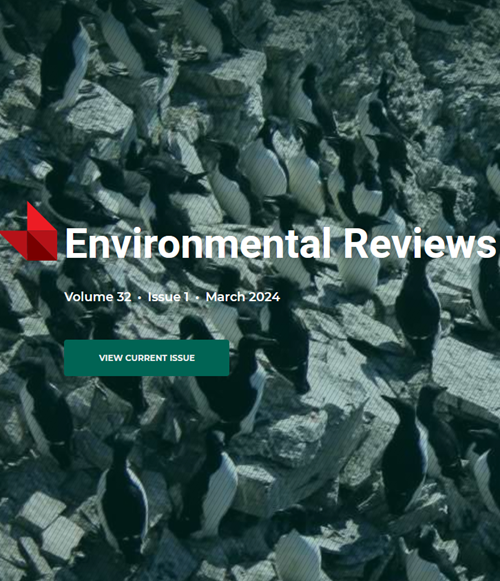The Acadian Forest of New Brunswick in the 21st century: what shifting heat and water balance implies for future stand dynamics and management
IF 5.1
3区 环境科学与生态学
Q2 ENVIRONMENTAL SCIENCES
引用次数: 0
Abstract
Climate change is altering the dynamics of New Brunswick's forests. To mitigate the effects of climate change, it is crucial to account for future uncertainties in climate projections and natural disturbance trajectories when designing forestry practices. This paper presents the projected changes in key climatic drivers for New Brunswick's forests, examines the impacts of climate change on forest stand dynamics, and reviews adaptive silviculture tools for climate change adaptation. By 2071-2100, a projected 4-6°C increase in mean annual temperature will lead to a 39-77% rise in growing degree days and a reduction in summer atmospheric water balance by 48-79mm across New Brunswick. Foresters should anticipate a doubling of annual area burned, the northward migration of spruce budworm (Choristoneura fumiferana (Clemens)), and the introduction of novel insects and diseases. Forest simulation models project a severe decline in boreal tree species abundance, including a 50% decline in balsam fir (Abies balsamea (L.) Mill) and black spruce (Picea mariana (Mill) B.S.P.), offset by an increase in temperate species, notably red maple (Acer rubrum L.; +200%) and American beech (Fagus grandifolia Ehrh; +135%). Forests in the highlands and lowlands ecoregions, with 40-50% and 15-30% spruce and balsam fir composition respectively, are particularly vulnerable. To limit climate change effects on forest values, foresters must prioritize climate resiliency in their management plans. Strategies should ensure the steady provision of forest goods and services under changing climatic conditions. Forest thinning enhances stand productivity and resilience, while shelterwood and two-age harvest balances timber production with diversity. Clearcutting, despite drawbacks, establishes younger, more vigorous forests with higher carbon sequestration potential. Assisted migration offers promise in helping threatened tree species adapt. Climate change will have a significant impact on New Brunswick's forests, leading to changes in key climatic drivers, increased risks of disturbances, and a shift towards more temperate tree species. However, there are existing adaptation strategies available. It is crucial to consider future uncertainties when designing and evaluating forestry practices, as this is essential for mitigating the effects of climate change on forest values and ensuring the continued provision of forest goods and services over time.21世纪新不伦瑞克的阿卡迪亚森林:热量和水分平衡的变化对未来林分动态和管理意味着什么
气候变化正在改变新不伦瑞克省森林的动态。为了减轻气候变化的影响,在设计林业实践时,考虑到气候预测和自然扰动轨迹中的未来不确定性至关重要。本文介绍了新不伦瑞克省森林关键气候驱动因素的预计变化,研究了气候变化对林分动态的影响,并回顾了适应气候变化的适应性造林工具。到2071-2100年,预计年平均气温将上升4-6°C,新不伦瑞克省的生长度天数将增加39-77%,夏季大气水分平衡将减少48-79毫米。森林学家应该预计每年被烧毁的面积会翻一番,云杉虎皮虫(Choristonneura fumiferana(Clemens))会向北迁移,并会引入新的昆虫和疾病。森林模拟模型预测北方树种的丰度会严重下降,包括香脂冷杉(Abies baliea(L.)Mill)和黑云杉(Picea mariana(Mill)B.S.P.)下降50%,但被温带物种的增加所抵消,尤其是红枫(Acer rubrum L.;+200%)和美国山毛榉(Fagus grandifolia Ehrh;+135%)。高地和低地生态区的森林尤其脆弱,云杉和香脂冷杉分别占40-50%和15-30%。为了限制气候变化对森林价值的影响,林业工作者必须在其管理计划中优先考虑气候恢复能力。战略应确保在不断变化的气候条件下稳定地提供森林产品和服务。森林疏伐提高了林分生产力和恢复力,而防护林和两龄采伐则平衡了木材生产和多样性。尽管存在缺点,但砍伐森林可以建立更年轻、更有活力、碳固存潜力更高的森林。协助迁徙有望帮助受威胁的树种适应。气候变化将对新不伦瑞克省的森林产生重大影响,导致关键气候驱动因素发生变化,干扰风险增加,并向更温和的树种转变。然而,现有的适应战略是可用的。在设计和评估林业做法时,必须考虑到未来的不确定性,因为这对于减轻气候变化对森林价值的影响和确保随着时间的推移继续提供森林产品和服务至关重要。
本文章由计算机程序翻译,如有差异,请以英文原文为准。
求助全文
约1分钟内获得全文
求助全文
来源期刊

Environmental Reviews
环境科学-环境科学
自引率
3.50%
发文量
45
期刊介绍:
Published since 1993, Environmental Reviews is a quarterly journal that presents authoritative literature reviews on a wide range of environmental science and associated environmental studies topics, with emphasis on the effects on and response of both natural and manmade ecosystems to anthropogenic stress. The authorship and scope are international, with critical literature reviews submitted and invited on such topics as sustainability, water supply management, climate change, harvesting impacts, acid rain, pesticide use, lake acidification, air and marine pollution, oil and gas development, biological control, food chain biomagnification, rehabilitation of polluted aquatic systems, erosion, forestry, bio-indicators of environmental stress, conservation of biodiversity, and many other environmental issues.
 求助内容:
求助内容: 应助结果提醒方式:
应助结果提醒方式:


